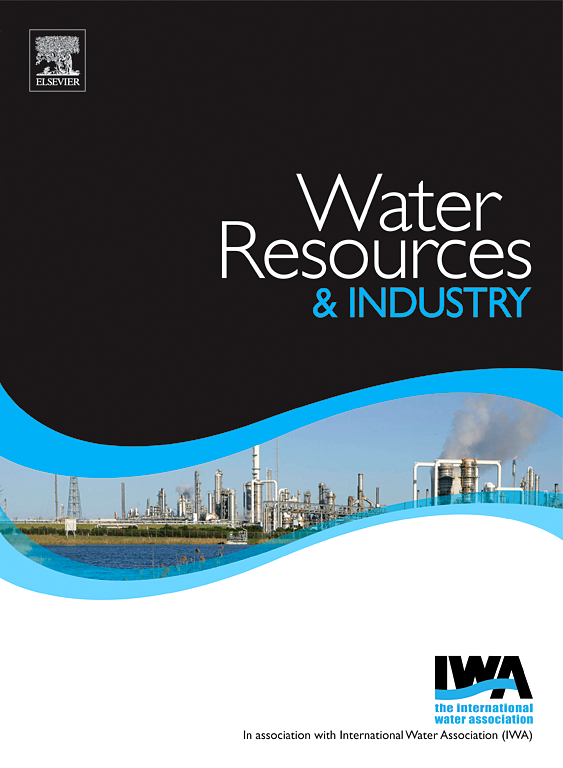利用电阻率和水化学数据评价地下水中的碳氢化合物和共污染物以及相关的公共健康风险
IF 7.5
3区 工程技术
Q1 WATER RESOURCES
引用次数: 0
摘要
碳氢化合物在国家和全球经济发展中起着至关重要的作用。然而,碳氢化合物的开采和利用对环境的影响仍然是一个具有挑战性的现象,它对土壤、地下水和公众健康的影响要严重得多。本研究利用电阻率和水化学数据,提供炼油厂附近地下水中潜在碳氢化合物污染物(HCCs)和重金属(HMs)等共污染物的分布信息,以及可能存在的相关健康风险,以便进行有效的环境管理和公众健康保护。检测了HCCs的浓度和电阻率值的变化。评价了区域含水层对HCCS的脆弱性。根据研究结果,HCCs出现在深度为0.0 m - 3.5 m的超载表土中,其电阻率值在15,000 Ωm和60,000 Ωm之间变化。由于HCCs的存在,这些值超过了该地区已知的地下电阻率值。水化学数据记录表明,地下水中的HCCs浓度在0.342 mg/L - 0.572 mg/L之间。5口手挖井(HDW)的地下水总石油烃(TPH)水平:HDW 1(0.4721)、HDW 2(0.4517)、HDW 3(最高为0.5716)、HDW 4(0.4012)和HDW 5(最低为0.3421),高于石油资源管理局(DPR)。该地区含水层受到不同范围hcc的污染,锌为0.792 ~ 1.692 mg/L,铁为0.909 ~ 1.711 mg/L,铅为0.711 ~ 1.612 mg/L,铬为0.333 ~ 0.717 mg/L,镉为0.038 ~ 0.081 mg/L, pH值为5.3 ~ 7.1,电导率(EC)为0.524 ~ 0.777 mS/cm,与hcc引起的电阻率对比升高相对应。数据分析提供了对碳氢化合物和HMs的环境影响的全面了解,展示了石化工业活动如何渗入地下水系统,加剧了环境退化并对人类健康构成严重威胁。本文章由计算机程序翻译,如有差异,请以英文原文为准。
Evaluation of hydrocarbon and co-contaminants in groundwater and associated public health risks using electrical resistivity and hydrochemical data
Hydrocarbon plays a vital role in national and global economic development. However, the environmental impact of hydrocarbon extraction and utilization remains a challenging phenomenon, which has recorded a far worse impact on the soil, groundwater, and public health. This study applied resistivity and hydrochemical data to provide information about the distribution of potential hydrocarbon contaminants (HCCs) and co-contaminants such as heavy metals (HMs) in groundwater near a refinery and the possible associated health risks for effective environmental management and public health protection. The concentrations of HCCs and variations in electrical resistivity values were examined. The regional aquifer vulnerability to the HCCS was evaluated. Based on the study's outcomes, HCCs occur in the overburdened topsoil at depths of 0.0 m–3.5 m, with electrical resistivity values varying between 15,000 Ωm and 60,000 Ωm. These values exceeded the known subsurface resistivity values of the region as a result of the presence of HCCs. Hydrochemical data records indicate high concentrations of HCCs in groundwater ranging from 0.342 mg/L – 0.572 mg/L. The level of total petroleum hydrocarbons (TPH) in groundwater from five hand-dug wells (HDWs): HDW 1 (0.4721), HDW 2 (0.4517), HDW 3 (highest at 0.5716), HDW 4 (0.4012), and HDW 5 (lowest at 0.3421), over the Directorate of Petroleum Resources (DPR). The aquifer of the region was polluted with HMs owing to infiltrated HCCs in different range, i.e., 0.792–1.692 mg/L for zinc, 0.909–1.711 for iron, 0.711–1.612 mg/L for lead, 0.333–0.717 mg/L for chromium, and 0.038–0.081 mg/L for cadmium, and pH ranged from 5.3 to 7.1 and electrical conductivity (EC) from 0.524 to 0.777 mS/cm, corresponding to the elevated electrical resistivity contrast caused by HCCs. Data analysis provides a comprehensive understanding of the environmental impacts of hydrocarbons and HMs, demonstrating how petrochemical industrial activities infiltrate into groundwater systems, exacerbating environmental degradation and posing serious health threats to human beings.
求助全文
通过发布文献求助,成功后即可免费获取论文全文。
去求助
来源期刊

Water Resources and Industry
Social Sciences-Geography, Planning and Development
CiteScore
8.10
自引率
5.90%
发文量
23
审稿时长
75 days
期刊介绍:
Water Resources and Industry moves research to innovation by focusing on the role industry plays in the exploitation, management and treatment of water resources. Different industries use radically different water resources in their production processes, while they produce, treat and dispose a wide variety of wastewater qualities. Depending on the geographical location of the facilities, the impact on the local resources will vary, pre-empting the applicability of one single approach. The aims and scope of the journal include: -Industrial water footprint assessment - an evaluation of tools and methodologies -What constitutes good corporate governance and policy and how to evaluate water-related risk -What constitutes good stakeholder collaboration and engagement -New technologies enabling companies to better manage water resources -Integration of water and energy and of water treatment and production processes in industry
 求助内容:
求助内容: 应助结果提醒方式:
应助结果提醒方式:


